Versatile nanobody-based approach to image, track and reconstitute functional Neurexin-1 in vivo
- PMID: 39025931
- PMCID: PMC11258300
- DOI: 10.1038/s41467-024-50462-2
Versatile nanobody-based approach to image, track and reconstitute functional Neurexin-1 in vivo
Abstract
Neurexins are key adhesion proteins that coordinate extracellular and intracellular synaptic components. Nonetheless, the low abundance of these multidomain proteins has complicated any localization and structure-function studies. Here we combine an ALFA tag (AT)/nanobody (NbALFA) tool with classic genetics, cell biology and electrophysiology to examine the distribution and function of the Drosophila Nrx-1 in vivo. We generate full-length and ΔPDZ ALFA-tagged Nrx-1 variants and find that the PDZ binding motif is key to Nrx-1 surface expression. A PDZ binding motif provided in trans, via genetically encoded cytosolic NbALFA-PDZ chimera, fully restores the synaptic localization and function of NrxΔPDZ-AT. Using cytosolic NbALFA-mScarlet intrabody, we achieve compartment-specific detection of endogenous Nrx-1, track live Nrx-1 transport along the motor neuron axons, and demonstrate that Nrx-1 co-migrates with Rab2-positive vesicles. Our findings illustrate the versatility of the ALFA system and pave the way towards dissecting functional domains of complex proteins in vivo.
© 2024. This is a U.S. Government work and not under copyright protection in the US; foreign copyright protection may apply.
Conflict of interest statement
F.O. is an inventor on a pending patent by NanoTag Biotechnologies GmbH that covers the ALFA system and its use (application numbers: WO2020053239A1; US20220048947A1; EP3849996A1; CN113195516A; JP2022500076A). F.O. is a shareholder of NanoTag Biotechnologies GmbH. The remaining authors declare no competing interests.
Figures
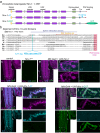
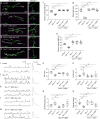
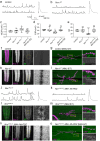
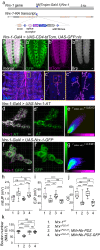
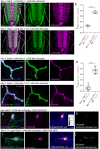
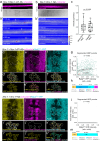
Similar articles
-
The neuronal protein Neurexin directly interacts with the Scribble-Pix complex to stimulate F-actin assembly for synaptic vesicle clustering.J Biol Chem. 2017 Sep 1;292(35):14334-14348. doi: 10.1074/jbc.M117.794040. Epub 2017 Jul 14. J Biol Chem. 2017. PMID: 28710284 Free PMC article.
-
Drosophila neurexin IV interacts with Roundabout and is required for repulsive midline axon guidance.J Neurosci. 2010 Apr 21;30(16):5653-67. doi: 10.1523/JNEUROSCI.6187-09.2010. J Neurosci. 2010. PMID: 20410118 Free PMC article.
-
Cooperation of Syd-1 with Neurexin synchronizes pre- with postsynaptic assembly.Nat Neurosci. 2012 Sep;15(9):1219-26. doi: 10.1038/nn.3183. Epub 2012 Aug 5. Nat Neurosci. 2012. PMID: 22864612
-
Modulation of Trans-Synaptic Neurexin-Neuroligin Interaction in Pathological Pain.Cells. 2022 Jun 16;11(12):1940. doi: 10.3390/cells11121940. Cells. 2022. PMID: 35741069 Free PMC article. Review.
-
Axon guidance: motor-way madness.Curr Biol. 1996 Jul 1;6(7):794-7. doi: 10.1016/s0960-9822(02)00597-3. Curr Biol. 1996. PMID: 8835859 Review.
Cited by
-
PlexinA1 (PLXNA1) as a novel scaffold protein for the engineering of extracellular vesicles.J Extracell Vesicles. 2024 Nov;13(11):e70012. doi: 10.1002/jev2.70012. J Extracell Vesicles. 2024. PMID: 39508411 Free PMC article.
References
MeSH terms
Substances
Grants and funding
LinkOut - more resources
Full Text Sources
Molecular Biology Databases

